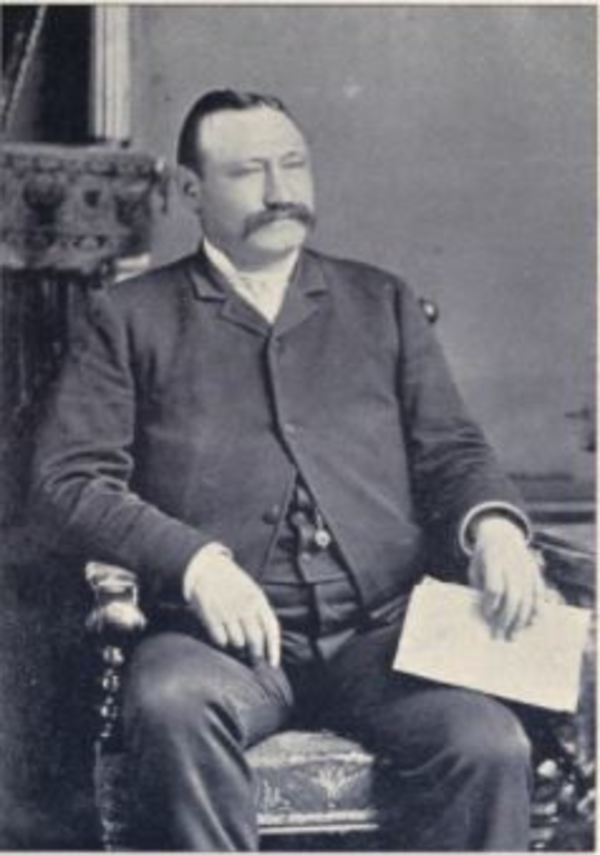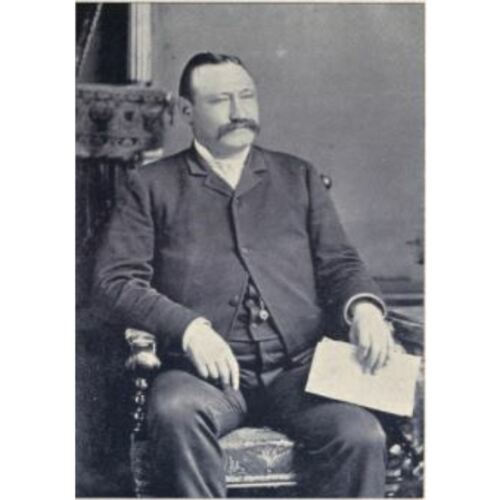
Source: Link
CONMEE, JAMES, contractor, office holder, politician, and businessman; b. 13 Oct. 1848 in Sydenham Township, Upper Canada, son of Matthew Conmee and Rosanna O’Shaughnessy; m. 12 Oct. 1874 Emily Florence Cox in St Vincent Township, Ont., and they had seven daughters and one son; d. 23 July 1913 in Prescott, Ariz., and was buried in Port Arthur (Thunder Bay), Ont.
James Conmee grew up in the Irish Block of Sydenham Township, the son of poor Irish immigrants. One source indicates that he attended local schools till age 15, but later accounts, supported by Conmee’s poor grammatical skills, stress his lack of education. In the last month of the American Civil War, he and his brother trained as volunteers with the 8th New York Regiment of Cavalry, an experience that would lead to exaggerated newspaper and family accounts and the enhancement of James’s frontier image as a fighter and man of adventure. He first came to Fort William (Thunder Bay) in 1872 to work at the sawmill of Adam Oliver* and Joseph Davidson on the Kaministiquia River, where he quickly showed entrepreneurial ability. In 1876–77 he held the contract to carry the mail between Silver Islet and Pigeon River. Conmee then took up lumbering and railway contracting. His work laying rails for the Prince Arthur’s Landing and Kaministiquia Railway in 1877 led to more important contracts with the Pacific railway: on government-controlled Section A, then, in partnership with John Donald McLennan, on the stretch between Port Arthur and Current River, and finally on the remote Michipicoten section north of Lake Superior.
Conmee began his public career in 1878 as assessor and tax collector for the municipality of Shuniah. The following year he became councillor for its most populous ward, Prince Arthur’s Landing South. Detractors were comparing him to an uneducated but wily Chicago alderman by November 1881. That year, while working in the wilderness in mid winter on Section A, he demonstrated his gift for public debate by arguing with fellow Irishman James McTeigue the constitutionality of the Irish coercion bill introduced by the government of British prime minister William Ewart Gladstone. Within months of Conmee’s election as mayor of Port Arthur in December 1884, the division of Algoma into two ridings allowed him to move to provincial politics as the successful Liberal candidate in the by-election of July 1885 in Algoma West. In early 1886 he made an impressive first speech to the legislature, which captured the attention of the Toronto press and Oliver Mowat*’s ministers because of its defence of provincial rights, and he soon cut a colourful figure in Toronto as an “M.P.P., statesman, patriot, thinker, owner of saw mills and builder of railways.” Charged in 1885 with defrauding the Canadian Pacific Railway on Lake Superior contracts, he emerged victorious from his legal battles in 1889, his reputation as a fighter enhanced with voters and the press because of the large amounts of money at stake and the legal talent involved (Britton Bath Osler* and D’Alton McCarthy* among others). As one of the few Catholic members of the legislature, he would prove useful to the government in 1894 by introducing a bill permitting the optional use of the secret ballot in separate school elections.
After his election in 1885, he had continued to be associated with local railway projects as contractor for sections of the Port Arthur, Duluth and Western, the Ontario and Rainy River, and, most lucratively, the Algoma Central, with Charles Martin Bowman. Conmee early recognized the importance of franchises on municipal utilities. He allied himself and his company, the Port Arthur (Ontario) Telephone Company, with the Toronto Telephone Manufacturing Company in 1884 in a losing fight to maintain its franchise against the monopoly attached to the Bell patent [see Charles Fleetford Sise]. He pursued similarly ill-fated and undercapitalized water-power and electric-power schemes, notably the Port Arthur Water, Light and Power Company, the Sault Ste Marie Water, Gas and Light Company, and a development at Île aux Hérons in the Lachine rapids near Montreal. Critics were never quite sure of the nature of his financial or political involvement with these companies, or with the contracts awarded his son-in-law James Whalen of Port Arthur. The workingmen whose votes he courted discounted allegations that he cheated his workers; they preferred a man who created jobs. As the Toronto Empire tellingly observed in 1894, “He is a moneymaker before he is a politician.”
The depression brought on in the Thunder Bay area by the collapse of silver mining and the lack of venture capital in the early 1890s marked a turning-point in Conmee’s political career. Although he was generally a forceful defender of Liberal policies and would hold his seat (renamed Port Arthur and Rainy River in 1902) for the Liberals until 1904, he was forced to side with his constituents against the Liberal government’s mining legislation, which increased state control over the industry and its revenues. This opposition damaged any chance Conmee, who was the founding president of the Ontario Mining Institute in 1894, may have had of becoming the province’s first minister of mines. His championship of mining and utilities interests culminated in 1899 when he secured an amendment to the Municipal Act which required municipalities to buy out privately owned electrical and gas utilities before inaugurating their own, legislation founded on Conmee’s experience as a promoter.
Conmee had tried in 1896 to move to federal politics by running in the new riding of Nipissing. Provincially the successive governments of Arthur Sturgis Hardy* and George William Ross faltered, tarnished in part by Conmee’s electoral indiscretions and his involvement with railway and utility companies which required legislative action, and at the end of the 10th Legislature in 1904 Conmee baled out. He was easily elected to the House of Commons for Thunder Bay and Rainy River that year and again in 1908 on the strength of the transcontinental railway policy of Sir Wilfrid Laurier’s government, which led to large federal expenditures in northwestern Ontario and on the Lakehead harbour. His primary interest in these years became the development of water and electric power.
Conmee was arguably the major political figure of his generation in northern Ontario. At his peak in the 1890s he was known as Fighting Jim and the People’s Jim (after Gladstone, the People’s William). His constituents found in him a man like themselves, “schooled to hardships and adversity.” They shared his attitudes towards northern development and the exploitation of resources. He could claim credit, with Daniel Francis Burk and a few others, for making “New Ontario,” and the Rainy River District in particular, known to Toronto politicians. He also became a favourite of Toronto journalists and political cartoonists. They marvelled that this bull of a man, five feet five inches in height and more than 300 pounds in weight, who took part in wrestling contests into the 1870s and possessed little education, could speak with such forceful eloquence and pen the words of a patriotic song, “The national flag,” to the music of Henry Herbert Godfrey*. Conmee’s character was summarized in the Toronto Globe headline announcing his death: “A self-made man, and essentially democratic, of natural talent, and intense perseverance – a strong debater and remarkable personality.” Ill health had forced him to retire from politics in 1911 and to winter in warmer climates. In 1913 he died in Arizona, leaving an estate valued at $245,347, much of it in property.
A copy of the sheet music for the song Conmee co-wrote with Henry Herbert Godfrey, The national flag (Toronto, 1898), is in the National Library of Canada, Ottawa, Music div.
AO, F 644, MU 21-22; RG 22-398, 1913, no.775. NA, MG 26, G; MG 28, III 20, Van Horne letter-books, 4: 989–92; 14: 671; 19: 996; 33: 526–27; Shaughnessy letter-books, 4: 316, 339, 976; 5: 106–7; 38: 938 (copies); RG 31, C1, 1861, Sydenham Township, [Ont.]; 1881, 1891, Algoma, Ont.; RG 43, AIII, 1, 751, file 1958. National Arch. (Washington), RG 94 (records of the Adjutant General’s Office), Record and pension office records, 8th New York Regiment of Cavalry, Enlistment records, James Conway [Conmee]; Pension file, John Conway [Conmee], files 894411 and 950517. Daily Journal (Fort William [Thunder Bay], Ont.), 24–25 Aug. 1898. Daily News (Port Arthur [Thunder Bay]), 4, 11, 15 Jan. 1910; 24 July 1913. Daily Sentinel (Port Arthur), 12–15 Aug. 1884, 14 Jan. 1889. Daily Times-Journal (Fort William), 2–4 Nov. 1904, 4 July 1905, 24 July 1913. Empire (Toronto), 29 Jan., 12 Feb. 1894. Evening Star (Toronto), 27 Aug., 19 Sept. 1896, continued as Toronto Daily Star, 24 July 1913. Globe, 30 Jan. 1886, 30 March 1905, 12 March 1910 (Saturday magazine), 24 July 1913. News-Chronicle (Port Arthur), 12 April 1933. Owen Sound Sun (Owen Sound, Ont.), 25 July 1913. Toronto Daily Mail, 30 Jan. 1886, 24 April 1891, 16 Feb. 1894. Weekly Herald and Algoma Miner (Prince Arthur’s Landing, later Port Arthur), 1882–1901. Weekly Sentinel (Prince Arthur’s Landing; Port Arthur), 1876–94. World (Toronto), 22 Feb., 12–22 March 1897. M. E. Arthur, “The frontier politician,” in Aspects of nineteenth-century Ontario . . . , ed. F. H. Armstrong et al. (Toronto and Buffalo, N.Y., 1974), 278–96. Can., House of Commons, Journals, 1905, app., vol.2: 101. Canadian album (Cochrane and Hopkins), 3: 29. Canadian men and women of the time (Morgan; 1898). Laurel Conmee Whalen, “Incidents in the life of James Conmee, 1848–1913,” Thunder Bay Hist. Museum Soc., Papers and Records, 11 (1983): 53–62. Cyclopædia of Canadian biog. (Rose and Charlesworth), vol.2. In the High Court of Justice, Queen’s Bench Division: between Conmee & McLennan, plaintiffs, and the Canadian Pacific Railway Company, defendants: 33 mile contract . . . pleadings; McCarthy, Osler, Hoskin & Creelman, plaintiffs’ solicitors; Wells & MacMurchy, defendants’ solicitors ([Toronto], 1889). Saturday Night, 2 Aug. 1913: 3.
Cite This Article
F. Brent Scollie, “CONMEE, JAMES,” in Dictionary of Canadian Biography, vol. 14, University of Toronto/Université Laval, 2003–, accessed December 26, 2025, https://www.biographi.ca/en/bio/conmee_james_14E.html.
The citation above shows the format for footnotes and endnotes according to the Chicago manual of style (16th edition). Information to be used in other citation formats:
| Permalink: | https://www.biographi.ca/en/bio/conmee_james_14E.html |
| Author of Article: | F. Brent Scollie |
| Title of Article: | CONMEE, JAMES |
| Publication Name: | Dictionary of Canadian Biography, vol. 14 |
| Publisher: | University of Toronto/Université Laval |
| Year of publication: | 1998 |
| Year of revision: | 1998 |
| Access Date: | December 26, 2025 |



